The Distribution of Surface Soil Moisture over Space and Time in Eastern Taylor Valley, Antarctica
Abstract
:1. Introduction
2. Background
2.1. Soil Moisture in the McMurdo Dry Valleys
- Migration of water due to surface or subsurface flow. Soils adjacent to stream channels or lake margins receive a regular supply of liquid water as a result of surface or subsurface flow [41]. These are some of the few locations in the MDVs where surface soils can remain saturated throughout the active season.
- Melting of surface snow or subsurface ice deposits. The surface snow and buried ice deposits that do form throughout the valleys (typically in topographically sheltered locations where windblown snow can accumulate) are subject to continual melting throughout the active season, creating small refugia throughout the landscape that can support processes that demand access to more regular sources of liquid water [45,46]. Relatedly, the majority of the MDVs are underlain by shallow (≲1 m depth) ground ice, which has been shown to be subject to melting as a result of both a warming climate and due to unique landscape evolution processes [47,48].
- Deliquescence. The presence of abundant hygroscopic salts in the soils of Taylor Valley can result in the direct absorption of atmospheric water vapor when relative humidity exceeds a salt-dependent critical threshold [49]. Both laboratory [43,50,51] and field observations [51,52,53] have demonstrated the local effects of salt deliquescence in the MDVs.
2.2. Relating Soil Moisture and Albedo
3. Methods
3.1. Remote Sensing Image Calibration and Topographic Correction
3.2. Quantitatively Relating Relative Albedo to Gravimetric Water Content
| Source Location | Exp. # | Classification | Density (g cm−1) | Measured Field Capacity/Modeled Wilting Point a (GWC) | Exp. Duration | No. of Collected Spectra | Albedo (Air Dry) |
|---|---|---|---|---|---|---|---|
| 77.61726°S, 163.28593°E (Typical Soils) | 1 | Very Coarse Sand | 1.62 | 10.6%/5.3% | 122 min | 112 | 0.173 |
| 2 | Coarse Sand | 1.80 | 58 min | 64 | 0.192 | ||
| 77.61418°S, 163.30864°E (Dark Soils) | 3 | Fine Sand | 2.06 | 12.3%/6.1% | 116 min | 117 | 0.159 |
| 4 | Loamy Sand | 2.79 | 77 min | 74 | 0.138 |
3.3. Application to Remote Sensing Datasets
4. Results
4.1. Characteristics of Soil Samples
4.2. Relating Surface Albedo and Gravimetric Water Content
- Region #1. The uppermost optical surface of the sample is dry, with the recorded albedo equivalent to that of the air-dried samples. Because the depth of each soil experiment was held constant, the dominant control on the width of Region #1 is the capillarity of the soil, which influences the ability of water to rise through the sample.
- Region #3. The local albedo minimum marks the maximum GWC observable using our empirical technique. For the reasons discussed below, we consider this minimum to indicate that the surface is “optically saturated”.
- Region #4. A localized increase in apparent albedo with increasing GWC is observed in all samples and is associated with the transition from full saturation (lower GWC boundary), through partial inundation (albedo peak), and then to full inundation (upper GWC boundary). This feature is due to specular reflection (i.e., glinting) from individual surface grains as the surface tension of the water causes distortion around the grains. Region #4 is clearly resolvable when particle sizes are small (Exps. #2 and #4), but much more complex when particle sizes become large and heterogeneously wet during the experiment.
- Region #5. Once the samples are fully inundated, the albedo of the sample will continue to slowly decrease as water abundance (depth) increases.
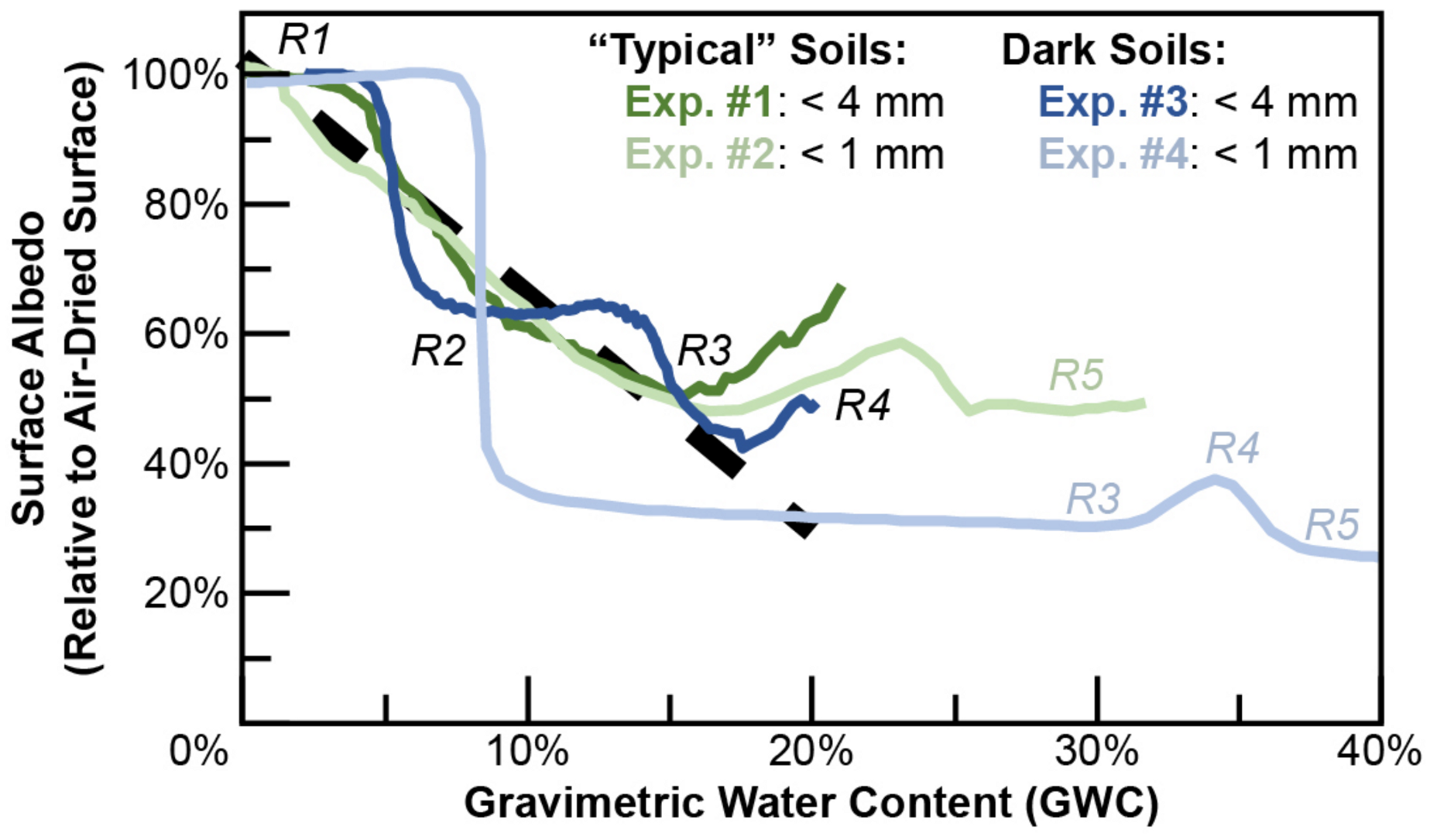
4.3. Application to Remote Sensing Data
5. Discussion
6. Conclusions
Supplementary Materials
Author Contributions
Funding
Data Availability Statement
Acknowledgments
Conflicts of Interest
Appendix A
| Platform | CAT/Image ID | Time of Acquisition (GMT) | Part of High-Quality Subset? |
|---|---|---|---|
| WV02 | 1030010003085D00 | 12/25/2009 18:40:39 | Yes |
| WV02 | 1030010003085D00 | 12/25/2009 18:40:40 | |
| WV02 | 1030010003AF300 | 12/25/2009 21:59:36 | Yes |
| WV02 | 1030010003A9F300 | 12/25/2009 21:59:37 | |
| WV02 | 1030010003921200 | 01/10/2010 20:36:08 | |
| WV02 | 1030010004306300 | 02/13/2010 21:36:33 | Yes |
| WV02 | 1030010007B79300 | 10/24/2010 19:48:32 | Yes |
| WV02 | 103001000834C800 | 11/20/2010 21:47:15 | |
| WV02 | 1030010008188100 | 11/27/2010 20:53:06 | |
| WV02 | 103001000823BF00 | 12/16/2010 21:04:04 | |
| WV02 | 103001000823BF00 | 12/16/2010 21:04:05 | |
| WV02 | 1030010008A27200 | 12/19/2010 20:55:05 | |
| WV02 | 1030010008A27200 | 12/19/2010 20:55:06 | Yes |
| WV02 | 103001000825E900 | 12/22/2010 20:46:12 | |
| WV02 | 1030010007823D00 | 12/25/2010 15:39:57 | Yes |
| WV02 | 103001000823AB00 | 12/26/2010 20:00:17 | |
| WV02 | 1030010009319D00 | 02/09/2011 21:03:38 | |
| WV02 | 1030010009319D00 | 02/09/2011 21:03:40 | |
| WV02 | 103001000FA6A800 | 11/01/2011 17:47:36 | |
| WV02 | 103001000F2F9F00 | 12/23/2011 19:15:40 | |
| WV02 | 10300100102C1200 | 01/20/2012 18:46:02 | |
| WV02 | 1030010011485B00 | 01/29/2012 19:54:39 | |
| WV02 | 10300100111D2700 | 02/03/2012 20:10:26 | Yes |
| WV02 | 10300100111D2700 | 02/03/2012 20:10:27 | |
| WV02 | 103001001B656700 | 09/30/2012 21:06:51 | |
| WV02 | 103001001B656700 | 09/30/2012 21:06:52 | |
| WV02 | 103001001D249700 | 10/31/2012 20:23:17 | |
| WV02 | 103001001D249700 | 10/31/2012 20:23:19 | |
| WV02 | 103001001D642400 | 01/05/2012 21:30:30 | Yes |
| WV02 | 103001001D642400 | 01/05/2012 21:30:31 | |
| WV02 | 103001001D0EE000 | 01/05/2013 21:30:52 | |
| WV02 | 103001001D0EE000 | 01/05/2013 21:30:53 | |
| WV02 | 103001001ED2C100 | 01/05/2013 21:31:38 | |
| WV02 | 103001001ED2C100 | 01/05/2013 21:31:40 | |
| WV02 | 103001001D381500 | 01/05/2013 21:31:58 | |
| WV02 | 103001001D381500 | 01/05/2013 21:31:59 | |
| WV02 | 103001002BD0AD00 | 12/27/2013 19:37:53 | |
| WV02 | 103001002CCCEE00 | 02/01/2014 20:52:40 | |
| WV02 | 103001002CCCEE00 | 02/01/2014 20:52:41 | |
| WV02 | 103001003ED2B400 | 01/21/2015 19:51:58 | Yes |
| WV03 | 1040010007721800 | 01/22/2015 20:12:31 | Yes |
| WV02 | 103001003CD3ED00 | 01/23/2015 20:17:49 | Yes |
| WV02 | 103001003D133E00 | 02/16/2015 20:33:10 | |
| WV02 | 103001004CAD8700 | 11/01/2015 20:12:42 | |
| WV03 | 1040010015737400 | 12/01/2015 21:15:44 | Yes |
| WV03 | 1040010018D33600 | 02/17/2016 20:09:42 | |
| WV02 | 10300100648C3100 | 01/25/2017 21:14:28 | Yes |
| WV03 | 104001002855C000 | 01/28/2017 21:00:46 | Yes |
| WV02 | 10300100643A1400 | 02/08/2017 20:57:28 | Yes |
| WV03 | 1040010029308E00 | 02/10/2017 21:09:28 | Yes |
| WV02 | 1030010063108000 | 02/14/2017 20:35:57 | |
| WV03 | 1040010028C25D00 | 02/15/2017 22:28:18 | Yes |
| WV02 | 10300100662D7100 | 02/25/2017 21:07:26 | Yes |
| WV02 | 1030010077755100 | 01/19/2018 19:06:05 | |
| WV02 | 1030010089D13500 | 12/11/2018 21:00:21 | Yes |
| WV03 | 10400100485D6900 | 01/26/2019 21:46:20 | Yes |
| WV02 | 103001009FA0AE00 | 12/03/2019 20:20:55 | Yes |
References
- Kennedy, A.D. Water as a Limiting Factor in the Antarctic Terrestrial Environment: A Biogeographical Synthesis. Arct. Alp. Res. 1993, 25, 308. [Google Scholar] [CrossRef]
- George, S.F.; Fierer, N.; Levy, J.S.; Adams, B. Antarctic water tracks: Microbial community responses to variation in soil moisture, pH, and salinity. Front. Microbiol. 2021, 12, 616730. [Google Scholar] [CrossRef] [PubMed]
- Freckman, D.W.; Virginia, R.A. Soil Biodiversity and Community Structure in the McMurdo Dry Valleys, Antarctica, in Ecosystem Processes in a Polar Desert: The McMurdo Dry Valleys, Antarctica. Antarct. Res. Ser. 1998, 72, 323–335. [Google Scholar]
- Wall, D.H. Biodiversity and ecosystem functioning in terrestrial habitats of Antarctica. Antarct. Sci. 2005, 17, 523–531. [Google Scholar] [CrossRef]
- Wlostowski, A.; Gooseff, M.N.; Adams, B. Soil Moisture Controls the Thermal Habitat of Active Layer Soils in the McMurdo Dry Valleys, Antarctica. J. Geophys. Res. Biogeosci. 2018, 123, 46–59. [Google Scholar] [CrossRef]
- Wharton, D.A. Anhydrobiosis. Curr. Biol. 2015, 25, R1114–R1116. [Google Scholar] [CrossRef] [Green Version]
- McKnight, D.M.; Tate, C.M.; Andrews, E.D.; Niyogi, D.K.; Cozzetto, K.; Welch, K.A.; Lyons, W.B.; Capone, D.G. Reactivation of a cryptobiotic stream ecosystem in the McMurdo Dry Valleys, Antarctica: A long-term geomorphological experiment. Geomorphology 2007, 89, 186–204. [Google Scholar] [CrossRef]
- Aguiar, M.R.; Sala, O.E. Patch structure, dynamics and implications for the functioning of arid ecosystems. Trends Ecol. Evol. 1999, 14, 273–277. [Google Scholar] [CrossRef]
- Barrett, J.E.; Virginia, R.A.; Wall, D.H.; Parsons, A.N.; Powers, L.E.; Burkins, M.B. Variation in biogeochemistry and soil biodiversity across spatial scales in a polar desert. Ecology 2004, 85, 3105–3118. [Google Scholar] [CrossRef]
- Schlesinger, W.H.; Raikes, J.A.; Hartley, A.E.; Cross, A.F. On the Spatial Pattern of Soil Nutrients in Desert Ecosystems. Ecology 1996, 77, 364–374. [Google Scholar] [CrossRef] [Green Version]
- Wall, D.H.; Virginia, R.A. Controls on soil biodiversity: Insights from extreme environments. Appl. Soil. Ecol. 1999, 13, 137–150. [Google Scholar] [CrossRef]
- Fell, J.W.; Scorzetti, G.; Connell, L.; Craig, S. Biodiversity of micro-eukaryotes in Antarctic Dry Valley soils with <5% soil moisture. Soil Biol. Biochem. 2006, 38, 3107–3119. [Google Scholar] [CrossRef]
- Wharton, D.A. The environmental physiology of Antarctic terrestrial nematodes: A review. J. Comp. Physiol. B 2003, 173, 621–628. [Google Scholar] [CrossRef] [PubMed]
- Wharton, D.A.; Goodall, G.; Marshall, C.J. Freezing survival and cryoprotective dehydration as cold tolerance mechanisms in the Antarctic nematode Panagrolaimus davidi. J. Exp. Biol. 2003, 206, 215–221. [Google Scholar] [CrossRef] [PubMed] [Green Version]
- Treonis, A.M.; Wall, D.H.; Virginia, R.A. The use of anhydrobiosis by soil nematodes in the Antarctic Dry Valleys. Funct. Ecol. 2000, 14, 460–467. [Google Scholar] [CrossRef]
- Adhikari, B.N.; Adams, B. Molecular analysis of desiccation survival in Antarctic nematodes. In Molecular and Physiological Basis of Nematode Survival; CABI International: Wallingford, UK, 2011; pp. 205–232. ISBN 978-1-84593-687-7. [Google Scholar]
- Levy, J.S.; Fountain, A.G.; Gooseff, M.N.; Barrett, J.E.; Vantreese, R.; Welch, K.A.; Lyons, W.B.; Nielsen, U.N.; Wall, D.H. Water track modification of soil ecosystems in the Lake Hoare basin, Taylor Valley, Antarctica. Antarct. Sci. 2014, 26, 153–162. [Google Scholar] [CrossRef] [Green Version]
- Colliander, A.; Jackson, T.J.; Bindlish, R.; Chan, S.; Das, N.; Kim, S.B.; Cosh, M.H.; Dunbar, R.S.; Dang, L.; Pashaian, L.; et al. Validation of SMAP surface soil moisture products with core validation sites. Remote Sens. Environ. 2017, 191, 215–231. [Google Scholar] [CrossRef]
- Nolan, M.; Fatland, D.R. Penetration depth as a DInSAR observable and proxy for soil moisture. IEEE Trans. Geosci. Remote Sens. 2003, 41, 532–537. [Google Scholar] [CrossRef] [Green Version]
- Levy, J.S.; Fountain, A.G.; Gooseff, M.N.; Welch, K.A.; Lyons, W.B. Water tracks and permafrost in Taylor Valley, Antarctica: Extensive and shallow groundwater connectivity in a cold desert ecosystem. Geol. Soc. Am. Bull. 2011, 123, 2295–2311. [Google Scholar] [CrossRef]
- Levy, J.; Nolin, A.; Fountain, A.; Head, J. Hyperspectral measurements of wet, dry and saline soils from the McMurdo Dry Valleys: Soil moisture properties from remote sensing. Antarct. Sci. 2014, 26, 565–572. [Google Scholar] [CrossRef] [Green Version]
- Clark, R.N.; King, T.V.V.; Klejwa, M.; Swayze, G.A.; Vergo, N. High spectral resolution reflectance spectroscopy of minerals. J. Geophys. Res. 1990, 95, 12653. [Google Scholar] [CrossRef] [Green Version]
- Salvatore, M.R.; Barrett, J.E.; Borges, S.R.; Power, S.N.; Stanish, L.F.; Sokol, E.R.; Gooseff, M.N. Counting Carbon: Quantifying Biomass in the McMurdo Dry Valleys through Orbital & Field Observations. Int. J. Remote Sens. 2021, 42, 8597–8623. [Google Scholar] [CrossRef]
- Kuentz, L.; Levy, J.; Salvatore, M. Timing and duration of ephemeral Antarctic water tracks and wetlands using high temporal–resolution satellite imagery, high spatial–resolution satellite imagery, and ground-based sensors in the McMurdo Dry Valleys. Arct. Antarct. Alp. Res. 2022, 54, 538–561. [Google Scholar] [CrossRef]
- Speirs, J.C.; Steinhoff, D.F.; McGowan, H.A.; Bromwich, D.H.; Monaghan, A.J. Foehn Winds in the McMurdo Dry Valleys, Antarctica: The Origin of Extreme Warming Events. J. Clim. 2010, 23, 3577–3598. [Google Scholar] [CrossRef] [Green Version]
- Fountain, A.G.; Lyons, W.B.; Burkins, M.B.; Dana, G.L.; Doran, P.T.; Lewis, K.J.; McKnight, D.M.; Moorhead, D.L.; Parsons, A.N.; Priscu, J.C.; et al. Physical controls on the Taylor Valley Ecosystem, Antarctica. BioScience 1999, 49, 961–972. [Google Scholar] [CrossRef]
- Obryk, M.K.; Doran, P.T.; Fountain, A.G.; Myers, M.; McKay, C.P. Climate from the McMurdo Dry Valleys, Antarctica, 1986–2017: Surface air temperature trends and redefined summer season. J. Geophys. Res. Atmos. 2020, 125, e2019JD032180. [Google Scholar] [CrossRef]
- Fountain, A.G.; Nylen, T.H.; Monaghan, A.; Basagic, H.J.; Bromwich, D. Snow in the McMurdo Dry Valleys, Antarctica. Int. J. Climatol. 2010, 30, 633–642. [Google Scholar] [CrossRef]
- Hall, B.L.; Denton, G.H.; Hendy, C.H. Evidence from Taylor Valley for a Grounded Ice Sheet in the Ross Sea, Antarctica. Geogr. Ann. Ser. Phys. Geogr. 2000, 82, 275–303. [Google Scholar] [CrossRef]
- Obryk, M.K.; Doran, P.T.; Waddington, E.D.; Mckay, C.P. The influence of föhn winds on Glacial Lake Washburn and palaeotemperatures in the McMurdo Dry Valleys, Antarctica, during the Last Glacial Maximum. Antarct. Sci. 2017, 29, 457–467. [Google Scholar] [CrossRef] [Green Version]
- Stuiver, M.; Denton, G.H.; Hughes, T.J.; Fasttook, J.L. History of the marine ice sheet in West Antarctica during the last glaciation: A working hypothesis. In The Last Great Ice Sheets; Denton, G.H., Hughes, T.J., Eds.; Wiley: New York, NY, USA, 1981; pp. 319–436. [Google Scholar]
- Toner, J.D.; Sletten, R.S.; Prentice, M.L. Soluble salt accumulations in Taylor Valley, Antarctica: Implications for paleolakes and Ross Sea Ice Sheet dynamics. J. Geophys. Res. Earth Surf. 2013, 118, 198–215. [Google Scholar] [CrossRef]
- Denton, G.H.; Bockheim, J.G.; Wilson, S.C.; Stuiver, M. Late Wisconsin and early Holocene glacial history, Inner Ross Embayment, Antarctica. Quat. Res. 1989, 31, 151–182. [Google Scholar] [CrossRef] [Green Version]
- Calkin, P.E. Geomorphology and Glacial Geology of the Victoria Valley System, Southern Victoria Land, Antarctica; The Ohio State University: Columbus, OH, USA, 1964; p. 66. [Google Scholar]
- Campbell, I.E.; Claridge, G.G.C. Antarctica: Soils, Weathering Processes, and Environment; Developments in Soil Science; Elsevier: New York, NY, USA, 1987; Volume 16, ISBN 0-444-42784-8. [Google Scholar]
- Campbell, I.B. Soil characteristics at a long-term ecological research site in Taylor Valley, Antarctica. Soil Res. 2003, 41, 351. [Google Scholar] [CrossRef]
- Campbell, I.B.; Claridge, G.G.C. Permafrost properties, patterns and processes in the Transantarctic Mountains region. Permafr. Periglac. Process. 2006, 17, 215–232. [Google Scholar] [CrossRef]
- Schmidt, L.M.; Levy, J.S. Hydraulic conductivity of active layer soils in the McMurdo Dry Valleys, Antarctica: Geological legacy controls modern hillslope connectivity. Geomorphology 2017, 283, 61–71. [Google Scholar] [CrossRef]
- Tsai, Y.-Z.; Liu, Y.-T.; Wang, Y.-L.; Chang, L.-C.; Hsu, S.-Y. Effects of the Grain Size on Dynamic Capillary Pressure and the Modified Green–Ampt Model for Infiltration. Geofluids 2018, 2018, e8946948. [Google Scholar] [CrossRef]
- Wolf, A.; Vos, M.; de Boer, W.; Kowalchuk, G. Impact of Matric Potential and Pore Size Distribution on Growth Dynamics of Filamentous and Non-Filamentous Soil Bacteria. PLoS ONE 2013, 8, e83661. [Google Scholar] [CrossRef] [PubMed] [Green Version]
- Gooseff, M.N.; McKnight, D.M.; Runkel, R.L.; Vaughn, B.H. Determining long time-scale hyporheic zone flow paths in Antarctic streams. Hydrol. Process. 2003, 17, 1691–1710. [Google Scholar] [CrossRef]
- Levy, J. Hydrological characteristics of recurrent slope lineae on Mars: Evidence for liquid flow through regolith and comparisons with Antarctic terrestrial analogs. Icarus 2012, 219, 1–4. [Google Scholar] [CrossRef]
- Levy, J.; Fountain, A.; Lyons, W.B.; Welch, K. Experimental formation of pore fluids in McMurdo Dry Valleys soils. Antarct. Sci. 2015, 27, 163–171. [Google Scholar] [CrossRef]
- McKnight, D.M.; Niyogi, D.K.; Alger, A.S.; Bomblies, A.; Conovitz, P.A.; Tate, C.M. Dry Valley Streams in Antarctica: Ecosystems Waiting for Water. BioScience 1999, 49, 985–995. [Google Scholar] [CrossRef]
- Eveland, J.; Gooseff, M.N.; Lampkin, D.J.; Barrett, J.E.; Takacs-Vesbach, C.D. Spatial and temporal patterns of snow accumulation and aerial ablation across the McMurdo Dry Valleys, Antarctica. Hydrol. Process. 2013, 27, 2864–2875. [Google Scholar] [CrossRef]
- Gooseff, M.N.; Barrett, J.E.; Doran, P.T.; Fountain, A.G.; Lyons, W.B.; Parsons, A.N.; Porazinska, D.; Virginia, R.A.; Wall, D.H. Snow patch influence on soil biogeochemical processes and invertebrate distribution in the McMurdo Dry Valleys, Antarctica. Arct. Antarct. Alp. Res. 2003, 35, 91–99. [Google Scholar] [CrossRef] [Green Version]
- Fountain, A.G.; Levy, J.S.; Gooseff, M.N.; Horn, D.J.V. The McMurdo Dry Valleys: A landscape on the threshold of change. Geomorphology 2014, 225, 25–35. [Google Scholar] [CrossRef]
- Levy, J.S.; Fountain, A.G.; Dickson, J.L.; Head, J.W.; Okal, M.; Marchant, D.R.; Watters, J. Accelerated thermokarst formation in the McMurdo Dry Valleys, Antarctica. Sci. Rep. 2013, 3, srep02269. [Google Scholar] [CrossRef] [Green Version]
- Tang, I.N.; Munkelwitz, H.R. Composition and temperature dependence of the deliquescence properties of hygroscopic aerosols. Atmos. Environ. Part Gen. Top. 1993, 27, 467–473. [Google Scholar] [CrossRef]
- Gough, R.V.; Chevrier, V.F.; Tolbert, M.A. Formation of liquid water at low temperatures via the deliquescence of calcium chloride: Implications for Antarctica and Mars. Planet. Space Sci. 2016, 131, 79–87. [Google Scholar] [CrossRef]
- Gough, R.V.; Wong, J.; Dickson, J.L.; Levy, J.S.; Head, J.W.; Marchant, D.R.; Tolbert, M.A. Brine formation via deliquescence by salts found near Don Juan Pond, Antarctica: Laboratory experiments and field observational results. Earth Planet. Sci. Lett. 2017, 476, 189–198. [Google Scholar] [CrossRef]
- Dickson, J.L.; Head, J.W.; Levy, J.S.; Marchant, D.R. Don Juan Pond, Antarctica: Near-surface CaCl2-brine feeding Earth’s most saline lake and implications for Mars. Sci. Rep. 2013, 3, 1166. [Google Scholar] [CrossRef] [Green Version]
- Levy, J. Episodic basin-scale soil moisture anomalies associated with high relative humidity events in the McMurdo Dry Valleys, Antarctica. Antarct. Sci. 2021, 33, 533–547. [Google Scholar] [CrossRef]
- Myers, M.E.; Doran, P.T.; Myers, K.F. Valley-floor snowfall in Taylor Valley, Antarctica, from 1995 to 2017: Spring, summer and autumn. Antarct. Sci. 2022, 34, 325–335. [Google Scholar] [CrossRef]
- Musick, H.B.; Pelletier, R.E. Response to soil moisture of spectral indexes derived from bidirectional reflectance in thematic mapper wavebands. Remote Sens. Environ. 1988, 25, 167–184. [Google Scholar] [CrossRef]
- Lesaignoux, A.; Fabre, S.; Briottet, X. Influence of soil moisture content on spectral reflectance of bare soils in the 0.4–14 μm domain. Int. J. Remote Sens. 2013, 34, 2268–2285. [Google Scholar] [CrossRef]
- Marakkala Manage, L.P.; Greve, M.H.; Knadel, M.; Moldrup, P.; de Jonge, L.W.; Katuwal, S. Visible-Near-Infrared Spectroscopy Prediction of Soil Characteristics as Affected by Soil-Water Content. Soil Sci. Soc. Am. J. 2018, 82, 1333–1346. [Google Scholar] [CrossRef]
- Stenberg, B.; Viscarra Rossel, R.A.; Mouazen, A.M.; Wetterlind, J. Chapter Five—Visible and Near Infrared Spectroscopy in Soil Science. In Advances in Agronomy; Sparks, D.L., Ed.; Academic Press: Burlington, VT, USA, 2010; Volume 107, pp. 163–215. [Google Scholar]
- Small, C.; Steckler, M.; Seeber, L.; Akhter, S.H.; Goodbred, S.; Mia, B.; Imam, B. Spectroscopy of sediments in the Ganges–Brahmaputra delta: Spectral effects of moisture, grain size and lithology. Remote Sens. Environ. 2009, 113, 342–361. [Google Scholar] [CrossRef]
- Graser, E.A.; Van Bavel, C.H.M. The effect of soil moisture upon soil albedo. Agric. Meteorol. 1982, 27, 17–26. [Google Scholar] [CrossRef]
- Ångström, A. The Albedo of Various Surfaces of Ground. Geogr. Ann. 1925, 7, 323–342. [Google Scholar] [CrossRef]
- Planet, W.G. Some comments on reflectance measurements of wet soils. Remote Sens. Environ. 1970, 1, 127–129. [Google Scholar] [CrossRef]
- Dolgov, S.I. Vinogradova Reflection coefficient of moist soils. Sov. Soil Sci. 1973, 5, 735–737. [Google Scholar]
- Gu, S.; Otsuki, K.; Kamichika, M. Albedo Characteristics of Tottori Sand Dune. J. Agric. Meteorol. 2000, 56, 217–225. [Google Scholar] [CrossRef]
- Idso, S.B.; Jackson, R.D.; Reginato, R.J.; Kimball, B.A.; Nakayama, F.S. The Dependence of Bare Soil Albedo on Soil Water Content. J. Appl. Meteorol. Climatol. 1975, 14, 109–113. [Google Scholar] [CrossRef]
- Lobell, D.B.; Asner, G.P. Moisture Effects on Soil Reflectance. Soil Sci. Soc. Am. J. 2002, 66, 722–727. [Google Scholar] [CrossRef]
- Weidong, L.; Baret, F.; Xingfa, G.; Qingxi, T.; Lanfen, Z.; Bing, Z. Relating soil surface moisture to reflectance. Remote Sens. Environ. 2002, 81, 238–246. [Google Scholar] [CrossRef]
- Fountain, A.G.; Fernandez-Diaz, J.C.; Obryk, M.K.; Levy, J.S.; Gooseff, M.N.; Horn, D.J.V.; Morin, P.; Shrestha, R. High-resolution elevation mapping of the McMurdo Dry Valleys, Antarctica, and surrounding regions. Earth Syst. Sci. Data 2017, 9, 435–443. [Google Scholar] [CrossRef] [Green Version]
- Weil, R.R.; Brady, N.C. The Nature and Properties of Soils, 15th ed.; Pearson: London, UK, 2016; ISBN 978-0-13-325448-8. Available online: https://www.pearson.com/store/p/nature-and-properties-of-soils-the/P100001303505/9780133254488 (accessed on 28 June 2022).
- Grewal, K.S.; Buchan, G.D.; Tonkin, P.J. Estimation of field capacity and wilting point of some New Zealand soils from their saturation percentages. N. Z. J. Crop. Hortic. Sci. 1990, 18, 241–246. [Google Scholar] [CrossRef]
- Bockheim, J.G.; Prentice, M.L.; McLeod, M. Distribution of Glacial Deposits, Soils, and Permafrost in Taylor Valley, Antarctica. Arct. Antarct. Alp. Res. 2008, 40, 279–286. [Google Scholar] [CrossRef] [Green Version]
- Bockheim, J. University of Wisconsin Antarctic Soils Database; NSIDC: National Snow and Ice Data Center: Boulder, CO, USA, 2003; Volume 1. [Google Scholar]
- Bishop, J.; Madejová, J.; Komadel, P.; Fröschl, H. The influence of structural Fe, Al and Mg on the infrared OH bands in spectra of dioctahedral smectites. Clay Miner. 2002, 37, 607–616. [Google Scholar] [CrossRef]
- Bishop, J.L.; Pieters, C.M.; Edwards, J.O. Infrared Spectroscopic Analyses on the Nature of Water in Montmorillonite. Clays Clay Miner. 1994, 42, 702–716. [Google Scholar] [CrossRef]
- Bishop, J.L.; Englert, P.A.J.; Patel, S.; Tirsch, D.; Roy, A.J.; Koeberl, C.; Böttger, U.; Hanke, F.; Jaumann, R. Mineralogical analyses of surface sediments in the Antarctic Dry Valleys: Coordinated analyses of Raman spectra, reflectance spectra and elemental abundances. Philos. Trans. R. Soc. Math. Phys. Eng. Sci. 2014, 372, 20140198. [Google Scholar] [CrossRef]
- Burns, R.G. Mineralogical Applications of Crystal Field Theory, 2nd ed.; Cambridge Topics in Mineral Physics and Chemistry; Cambridge University Press: Cambridge, UK, 1993; ISBN 978-0-521-43077-7. [Google Scholar]
- Bockheim, J.G. Evolution of desert pavements and the vesicular layer in soils of the Transantarctic Mountains. Geomorphology 2010, 118, 433–443. [Google Scholar] [CrossRef]
- Campbell, I.B.; Claridge, G.G.C. A classification of frigic soils—The zonal soils of the Antarctic continent. Soil Sci. 1969, 107, 75–85. [Google Scholar] [CrossRef]
- Turner, J.; Barrand, N.E.; Bracegirdle, T.J.; Convey, P.; Hodgson, D.A.; Jarvis, M.; Jenkins, A.; Marshall, G.; Meredith, M.P.; Roscoe, H.; et al. Antarctic climate change and the environment: An update. Polar. Rec. 2014, 50, 237–259. [Google Scholar] [CrossRef] [Green Version]
- Doran, P.T.; Priscu, J.C.; Lyons, W.B.; Walsh, J.E.; Fountain, A.G.; McKnight, D.M.; Moorhead, D.L.; Virginia, R.A.; Wall, D.H.; Clow, G.D.; et al. Antarctic climate cooling and terrestrial ecosystem response. Nature 2002, 415, 517–520. [Google Scholar] [CrossRef] [PubMed]
- Adams, B.; Connell, L.; Convey, P.; Fell, J.; Frati, F.; Hogg, I.; Newsham, K.; O’Donnell, A.; Russell, N.; Seppelt, R.; et al. Diversity and distribution of Victoria Land biota. Soil Biol. Biochem. 2006, 38, 3003–3018. [Google Scholar] [CrossRef]
- Hogg, I.D.; Stevens, M.I. Soil Fauna of Antarctic Coastal Landscapes. In Geoecology of Antarctic Ice-Free Coastal Landscapes; Beyer, L., Bölter, M., Eds.; Ecological Studies; Springer: Berlin/Heidelberg, Germany, 2002; Volume 154, pp. 265–280. ISBN 978-3-642-62674-6. [Google Scholar]
- Treonis, A.M.; Wall, D.H.; Virginia, R.A. Invertebrate biodiversity in Antarctic Dry Valley soils and sediments. Ecosystems 1999, 2, 482–492. [Google Scholar] [CrossRef]
- Or, D.; Wraith, J.M. Chapter 3: Soil Water Content and Water Potential Relationship. In Soil Physics Companion; Warrick, A.W., Ed.; CRC Press: Boca Raton, FL, USA, 2002; pp. 49–84. ISBN 978-1-4200-4165-1. [Google Scholar]
- Radcliffe, D.E.; Rasmussen, T.C. Chapter 4: Soil Water Movement. In Soil Physics Companion; Warrick, A.W., Ed.; CRC Press: Boca Raton, FL, USA, 2002; pp. 85–126. ISBN 978-1-4200-4165-1. [Google Scholar]
- Lyons, W.B.; Tyler, S.W.; Wharton, R.A., Jr.; McKnight, D.M.; Vaughn, B.H. A late Holocene dessication of Lake Hoare and Lake Fryxell, McMurdo Dry Valleys, Antarctica. Antarct. Sci. 1998, 10, 247–256. [Google Scholar] [CrossRef]
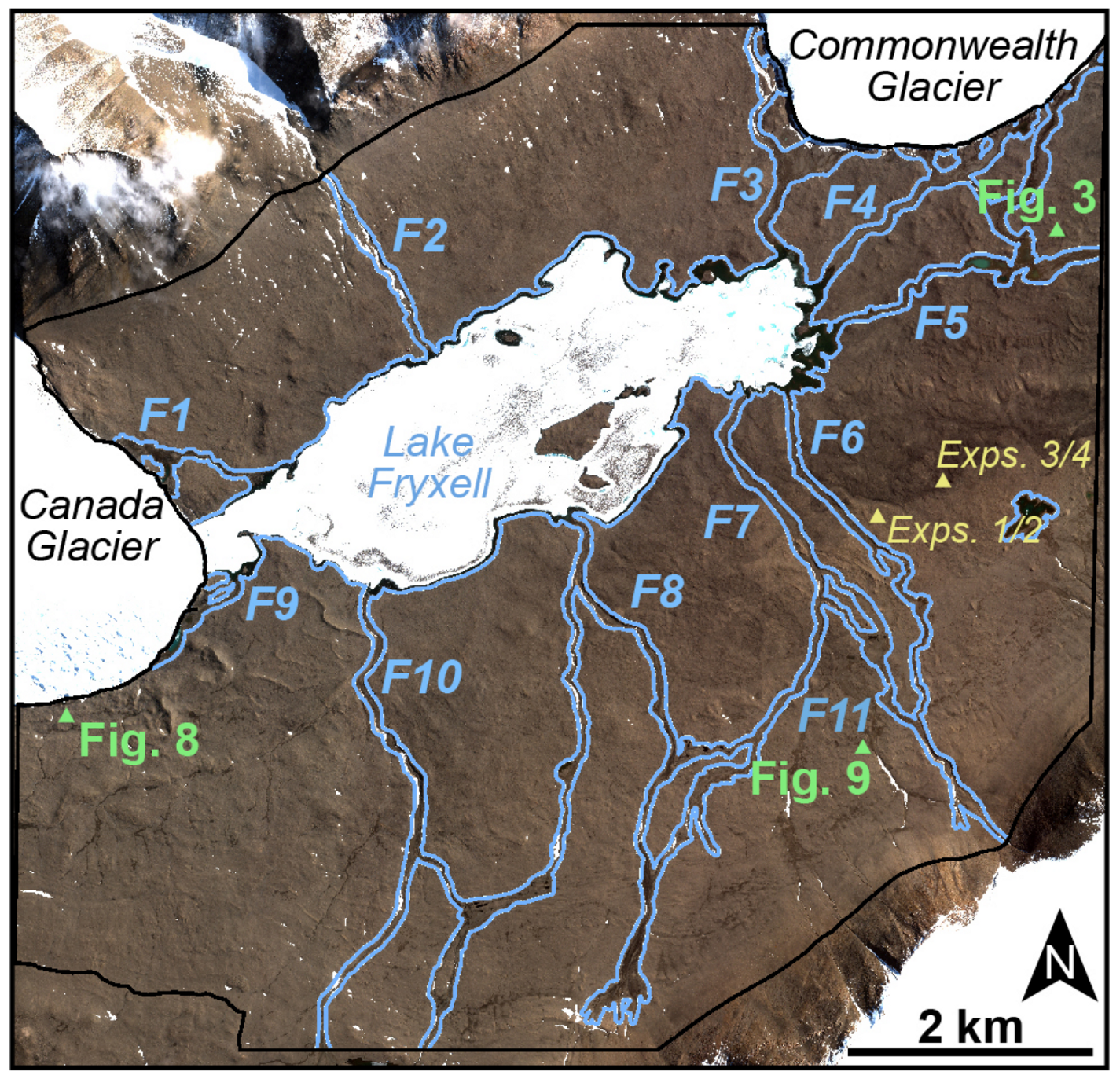
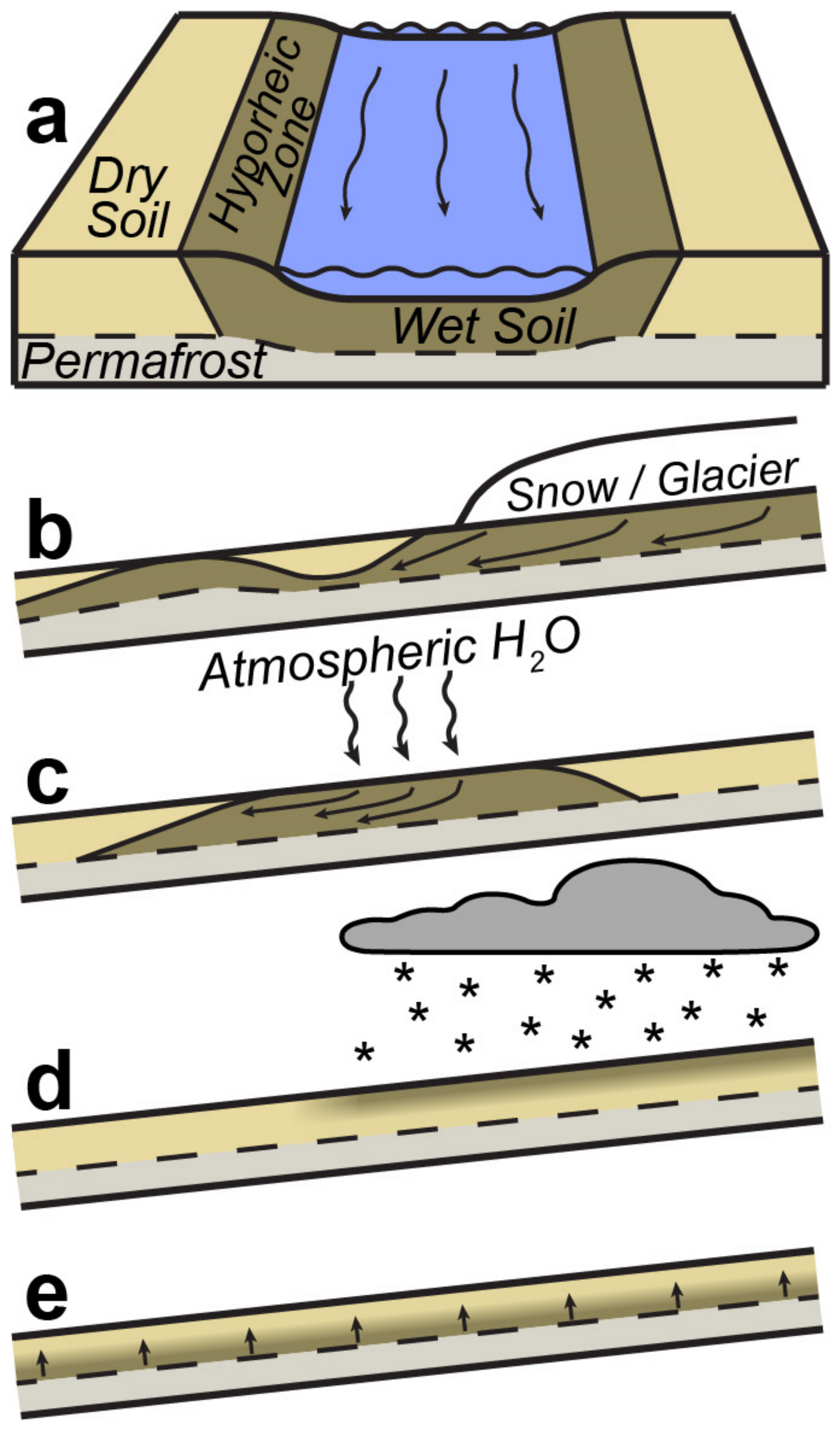

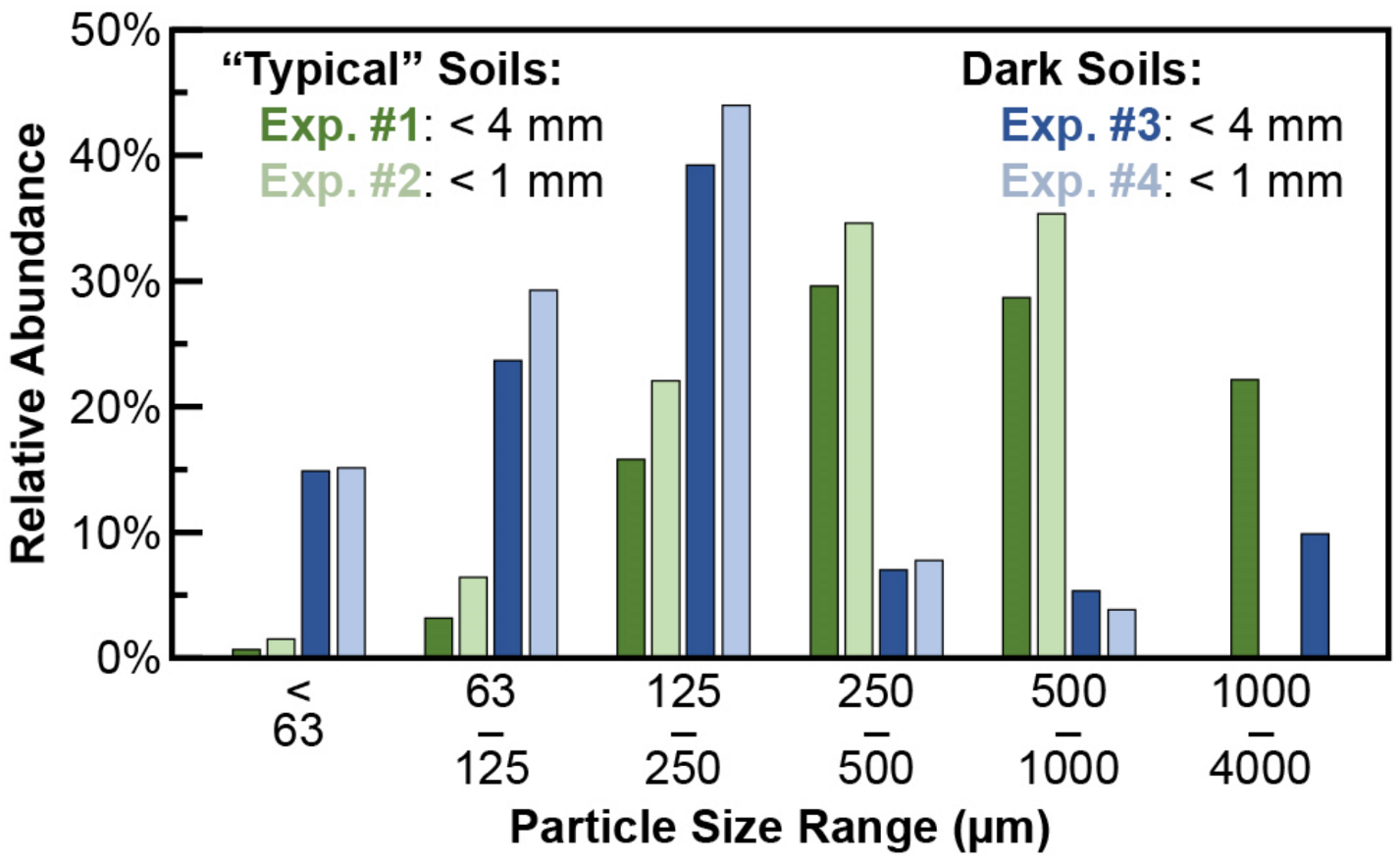
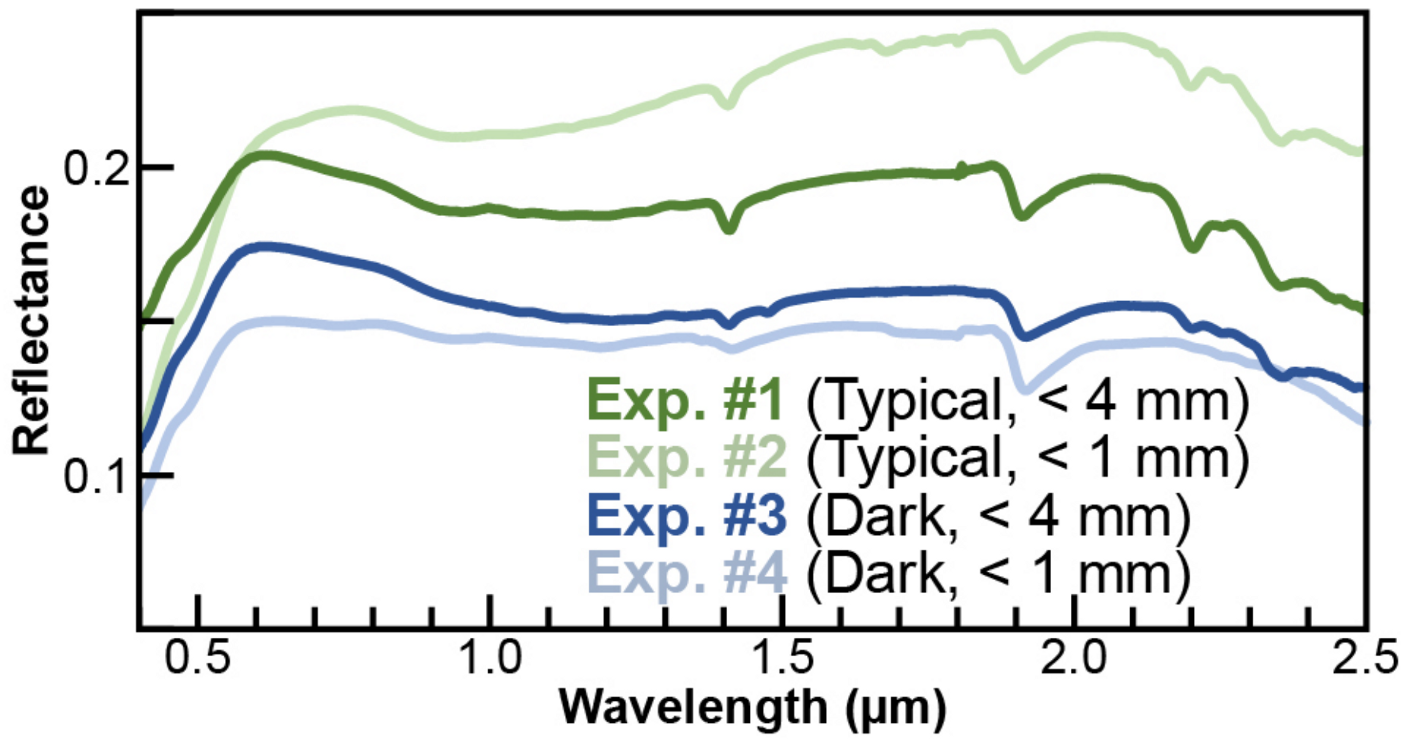

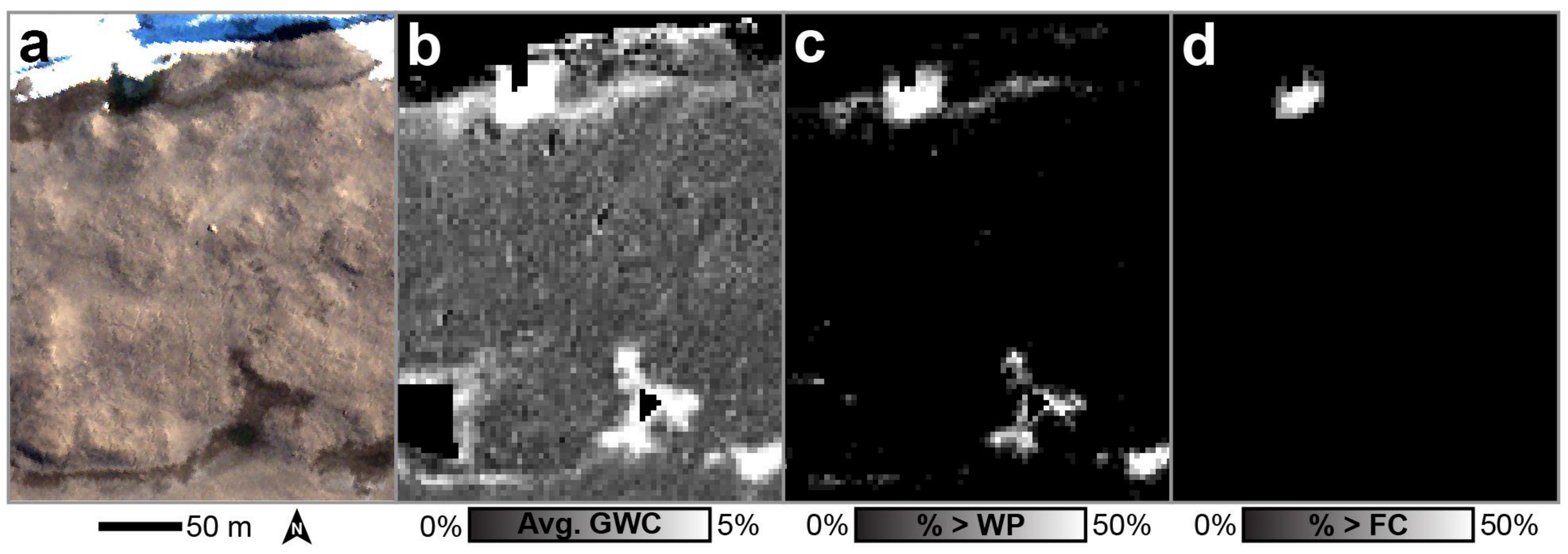
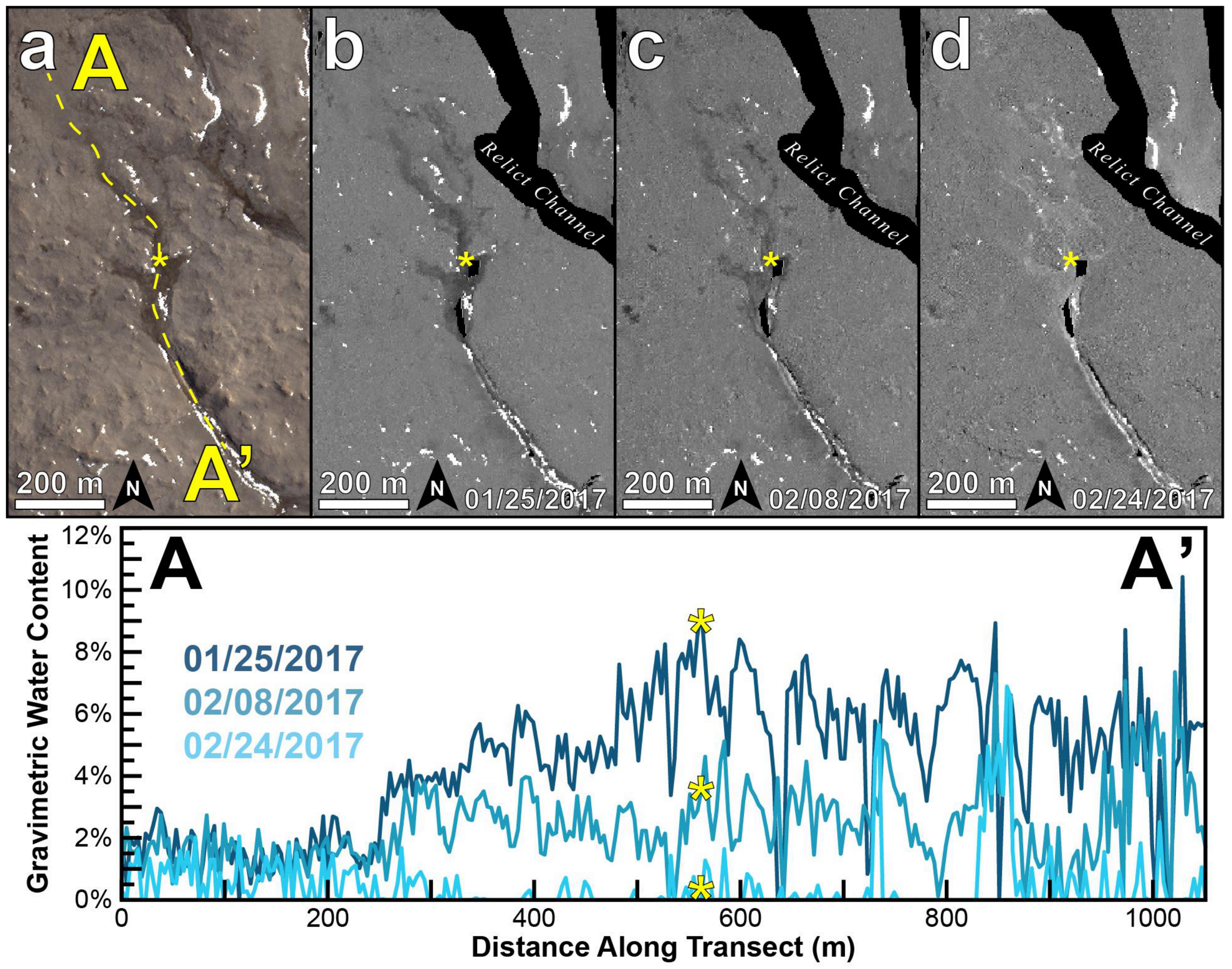
| Depth of Moist Active Layer | Interfluve Liquid Water Volume (Fryxell Basin) | Water Equivalent Layer (Fryxell Basin) | Fraction of Mean Annual Precipitation (50 mm weq [28]) |
|---|---|---|---|
| 0 cm | 0 m3 | 0 mm | 0% |
| 0.1 cm | 220 ± 73 m3 | 0.02 ± 0.01 mm | 0.04% |
| 1 cm | 2197 ± 735 m3 | 0.15 ± 0.05 mm | 0.30% |
| 5 cm | 10,984 ± 3674 m3 | 0.77 ± 0.26 mm | 1.54% |
| 25 cm | 54,918 ± 18,370 m3 | 3.84 ± 1.28 mm | 7.68% |
| 50 cm | 109,836 ± 36,741 m3 | 7.67 ± 2.57 mm | 15.34% |
| 100 cm | 219,673 ± 73,482 m3 | 15.35 ± 5.13 mm | 30.70% |
Disclaimer/Publisher’s Note: The statements, opinions and data contained in all publications are solely those of the individual author(s) and contributor(s) and not of MDPI and/or the editor(s). MDPI and/or the editor(s) disclaim responsibility for any injury to people or property resulting from any ideas, methods, instructions or products referred to in the content. |
© 2023 by the authors. Licensee MDPI, Basel, Switzerland. This article is an open access article distributed under the terms and conditions of the Creative Commons Attribution (CC BY) license (https://creativecommons.org/licenses/by/4.0/).
Share and Cite
Salvatore, M.R.; Barrett, J.E.; Fackrell, L.E.; Sokol, E.R.; Levy, J.S.; Kuentz, L.C.; Gooseff, M.N.; Adams, B.J.; Power, S.N.; Knightly, J.P.; et al. The Distribution of Surface Soil Moisture over Space and Time in Eastern Taylor Valley, Antarctica. Remote Sens. 2023, 15, 3170. https://doi.org/10.3390/rs15123170
Salvatore MR, Barrett JE, Fackrell LE, Sokol ER, Levy JS, Kuentz LC, Gooseff MN, Adams BJ, Power SN, Knightly JP, et al. The Distribution of Surface Soil Moisture over Space and Time in Eastern Taylor Valley, Antarctica. Remote Sensing. 2023; 15(12):3170. https://doi.org/10.3390/rs15123170
Chicago/Turabian StyleSalvatore, Mark R., John E. Barrett, Laura E. Fackrell, Eric R. Sokol, Joseph S. Levy, Lily C. Kuentz, Michael N. Gooseff, Byron J. Adams, Sarah N. Power, J. Paul Knightly, and et al. 2023. "The Distribution of Surface Soil Moisture over Space and Time in Eastern Taylor Valley, Antarctica" Remote Sensing 15, no. 12: 3170. https://doi.org/10.3390/rs15123170
APA StyleSalvatore, M. R., Barrett, J. E., Fackrell, L. E., Sokol, E. R., Levy, J. S., Kuentz, L. C., Gooseff, M. N., Adams, B. J., Power, S. N., Knightly, J. P., Matul, H. M., Szutu, B., & Doran, P. T. (2023). The Distribution of Surface Soil Moisture over Space and Time in Eastern Taylor Valley, Antarctica. Remote Sensing, 15(12), 3170. https://doi.org/10.3390/rs15123170





